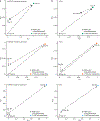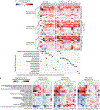Evaluating microbiome-directed fibre snacks in gnotobiotic mice and humans
- PMID: 34163075
- PMCID: PMC8324079
- DOI: 10.1038/s41586-021-03671-4
Evaluating microbiome-directed fibre snacks in gnotobiotic mice and humans
Abstract
Changing food preferences brought about by westernization that have deleterious health effects1,2-combined with myriad forces that are contributing to increased food insecurity-are catalysing efforts to identify more nutritious and affordable foods3. Consumption of dietary fibre can help to prevent cardiovascular disease, type 2 diabetes and obesity4-6. A substantial number of reports have explored the effects of dietary fibre on the gut microbial community7-9. However, the microbiome is complex, dynamic and exhibits considerable intra- and interpersonal variation in its composition and functions. The large number of potential interactions between the components of the microbiome makes it challenging to define the mechanisms by which food ingredients affect community properties. Here we address the question of how foods containing different fibre preparations can be designed to alter functions associated with specific components of the microbiome. Because a marked increase in snack consumption is associated with westernization, we formulated snack prototypes using plant fibres from different sustainable sources that targeted distinct features of the gut microbiomes of individuals with obesity when transplanted into gnotobiotic mice. We used these snacks to supplement controlled diets that were consumed by adult individuals with obesity or who were overweight. Fibre-specific changes in their microbiomes were linked to changes in their plasma proteomes indicative of an altered physiological state.
Conflict of interest statement
Declarations
J.I.G. is a co-founder of Matatu, Inc., a company characterizing the role of diet-by-microbiota interactions in animal health. A.O. and D.R. are co-founders of Phenobiome Inc., a company pursuing development of computational tools for predictive phenotype profiling of microbial communities. C.B.L is a co-founder of Evolve Biosystems, interVenn Bio, and BCD Bioscience, companies involved in the characterization of glycans and developing carbohydrate applications for human health.
D.K.H, A.M. and S.V. are employees of Mondelēz Global LLC, a multinational company engaged in production of snack foods. The remaining authors declare that they have no competing financial interests.
A patent application related to the fibre-snack formulations described in this report has been filed and published (WO 2021/016129).
Figures













Comment in
-
Designer fibre meals sway human gut microbes.Nature. 2021 Jul;595(7865):32-34. doi: 10.1038/d41586-021-01601-y. Nature. 2021. PMID: 34163080 No abstract available.
-
The gut microbiome in feast and famine.Nat Rev Gastroenterol Hepatol. 2021 Nov;18(11):749-750. doi: 10.1038/s41575-021-00514-5. Nat Rev Gastroenterol Hepatol. 2021. PMID: 34429532 No abstract available.
References
-
- Willett W et al. Food in the Anthropocene: the EAT–Lancet Commission on healthy diets from sustainable food systems. The Lancet 393, 447–492 (2019). - PubMed
-
- Hauner H et al. Evidence-based guideline of the German Nutrition Society: carbohydrate intake and prevention of nutrition-related diseases. Ann. Nutr. Metab 60, 1–58 (2012). - PubMed
-
- Reynolds A et al. Carbohydrate quality and human health: a series of systematic reviews and meta-analyses. The Lancet 393, 434–445 (2019). - PubMed

